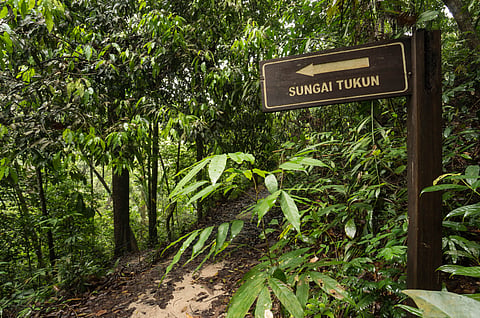
- Destinations
- Experiences
- Stay
- What's new
- Celebrating People
- Responsible Tourism
- CampaignsCampaigns
- Subscribe
- Buy Now

Malaysia is recognised as one of 12 mega-diverse countries in the world, with many of its species occurring in unusually high densities. For example, it is estimated that there are around 1,500 species of terrestrial vertebrates in its territory alone. Most of the country is covered in rainforest, and approximately 361 mammal species, 694 bird species, 250 reptile species, and 150 frog species have been recorded here. The Southeast Asian nation’s large marine territory also holds a great diversity of life, with the country's coastal waters comprising part of the Coral Triangle.
If you’re a nature lover looking to get up close and personal with Malaysia’s natural bounty, here are five of the best wildlife experiences you can have.
Like many caves around the world, the Gomantong Caves on the island of Borneo are home to millions of bats, but it’s the ubiquity of bird and bat guano, as well as a cave floor swarming with cockroaches and parasites, that truly makes it unique. A standard visit involves a trot counter-clockwise along the raised boardwalk that loops around the vast chamber. Besides cockroaches, you may spot freshwater cave crabs, giant centipedes, scorpions and lots of swiftlets and bats that occasionally fall to the cave floor and nourish the creatures that dwell in the excrement. If you happen to be outside the cave entrance at around 6 PM, you will see a vortex of bats stream out in search of food (unless it’s raining).
The main cave system is divided into two parts: the more accessible Simud Hitam (Black Cave) and the larger Simud Putih (White Cave), which lies above. Only the former is open to the public. For centuries, the caves have been renowned for their valuable edible swiftlet nests that are harvested for bird's nest soup. This is an ancient tradition, and the trading of these nests has been going on since at least 500 AD. Twice a year, from February to April and July to September, locals with licenses climb to the roof of the caves using only rattan ladders, ropes and bamboo poles to collect the nests.
Penang National Park is one of the world’s smallest forest reserves and is also home to the only meromictic lake in Malaysia. The site, located at the northwestern tip of Penang Island, is known to harbour 417 flora and 143 fauna species, including silvered leaf monkeys, flying lemurs, leopard cats and abundant bird, amphibian and reptile species. You can easily fill a day with activities such as jungle walks and boat trips to serene golden-sand beaches here. Boats can also be hired for day trips, barbeques and tours around the mangrove swamps.
Located about 20 miles from Semporna in Sabah, Sipadan is Malaysia’s only oceanic island of volcanic origin. As the top of a steep sea mountain, it rises from a 600-m abyss in the Celebes Sea. The island was originally declared a bird sanctuary in 1933 for migratory birds, and from 1981 onwards it became a marine reserve.
Ever since French marine biologist Jacques Yves-Cousteau revealed the island's natural wonders to the rest of the world in a documentary, diving has become very popular in Sipadan. The best diving season is from February to November, when visibility is about 20-60 m. Divers require a permit to dive in Sipadan, and the quota is capped at 176 permits per day (156 dive permits, 20 snorkelling special permits). Each permit is valid for one day only and can be obtained from dive resorts.
Sipadan is also the turtle capital of the world. Its large breeding colony of green and hawksbill turtles can grow up to one metre in carapace length and weigh more than 140 kg. Sipadan’s rich and diverse marine life also include more than 3,000 species of fish and hundreds of coral species. Besides turtles, schools of barracuda, bumphead parrotfish, manta rays, big-eye trevallies and hammerhead sharks are also frequently seen there.
The Sarawak River is the perfect place for a kayaking adventure. As you paddle along the scenic river, you will pass through a Bornean rainforest, limestone cliffs, local villages and waterfalls, and see (or hear) magnificent wildlife such as kingfishers and monitor lizards. The river also offers several chances for a refreshing swim, plenty of picnicking opportunities, and short treks to waterfalls and caves. The dry season from March to October is ideal for kayaking due to the calm river conditions.
Often hailed as Selangor’s most beautiful waterfall, the Chiling Waterfalls and Santuari Ikan Sungai Chiling (Mahseer Fish Sanctuary) are located just over an hour’s drive from Kuala Lumpur. The main aim of the sanctuary is to provide a safe haven for mahseer, a large freshwater fish. Today, the area has become an important habitat and natural breeding ground for the mahseer, which roam the creeks along the river to the main waterfall area. Visitors have the unique opportunity to feed the fish, with food available for purchase on-site.
